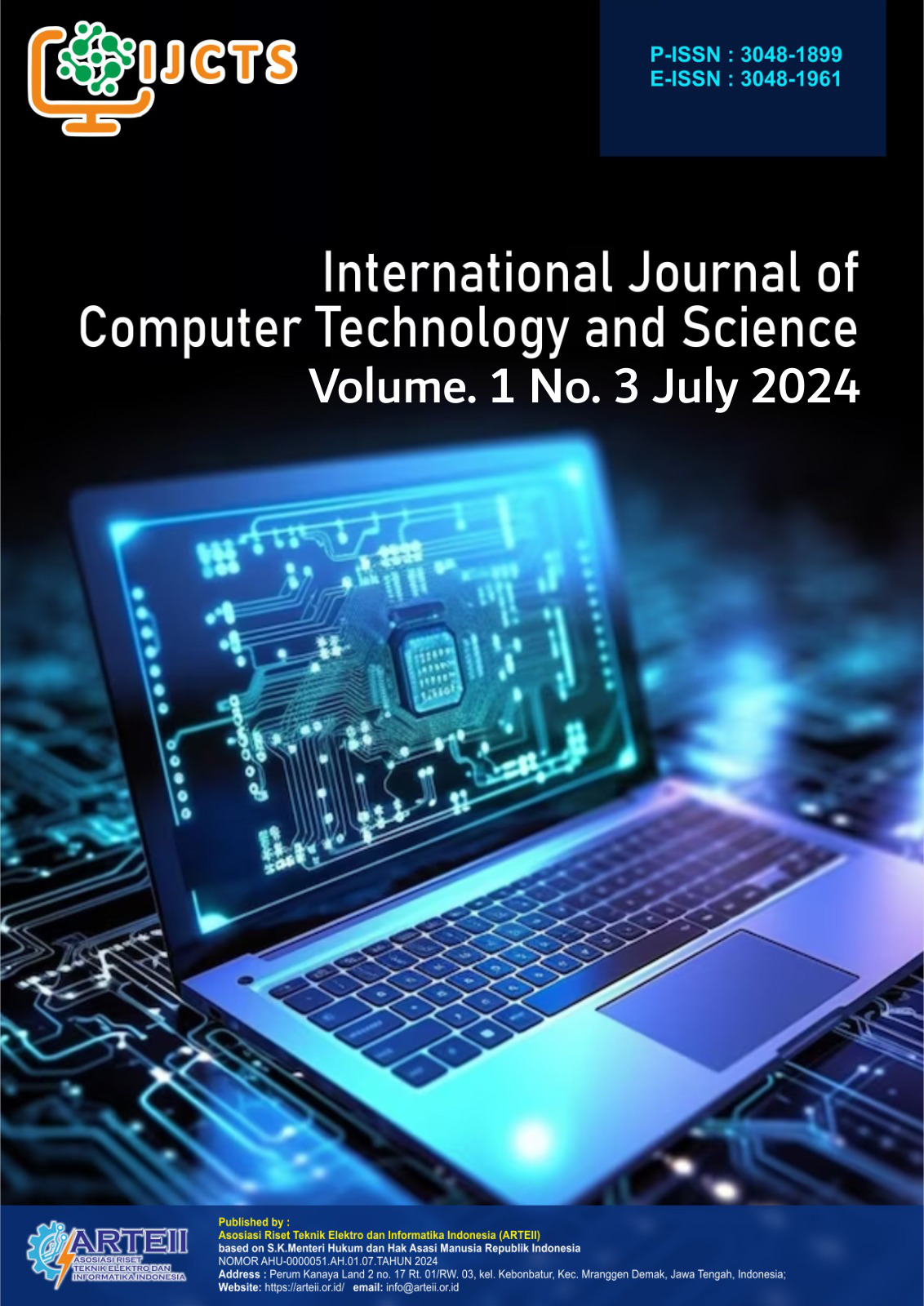Securing Industrial IoT: Blockchain-Integrated Solutions for Enhanced Privacy, Authentication, and Efficiency
DOI:
https://doi.org/10.62951/ijcts.v1i3.18Keywords:
Blockchain, IIoT, AuthenticationAbstract
The Industrial Internet of Things (IIoT) enhances the connectivity and efficiency of living lifestyles. However, it also comes with significant security vulnerabilities. Traditional authentication methods are often inadequate, leading to IIoT devices opened to security threats. This paper proposes a comprehensive security framework integrating blockchain, cryptographic techniques, smart contracts, and deep learning-based Intrusion Detection Systems (IDS) to tackle the mentioned issue. Blockchain ensures data integrity and prevents tampering through a decentralized ledger. A decentralized device identity management system enhances user verification, while secure communication protocols using Hash-based Message Authentication Codes (HMAC) safeguard data integrity. Smart contracts automate transactions, providing transparent, secure record-keeping without a central authority. The deep learning-based IDS, utilizing Contractive Sparse Autoencoder (CSAE) and Attention-Based Bidirectional Long Short-Term Memory (ABiLSTM) networks, effectively detects cyber threats. Evaluation metrics, including precision, recall, F1-score, and False Acceptance Rate (FAR), demonstrate high accuracy and low false alarm rates across datasets. This framework addresses the need for secure, efficient, and scalable authentication in IIoT, combining blockchain's security features with advanced cryptographic and anomaly detection techniques, offering robust defence against cyber threats.
References
Abbasi, I. A., et al. (2024). "A lightweight and robust authentication scheme for the healthcare system using public cloud server." Plos one 19(1): e0294429.
Abdullah Ayub Khan et al., “Data Security in Healthcare Industrial Internet of Things with Blockchain,” IEEE Sensors Journal, vol. 23, no. 20, pp. 25144–25151, Oct. 2023, doi: https://doi.org/10.1109/jsen.2023.3273851 .
Ahamed Aljuhani et al., “A Deep Learning Integrated Blockchain Framework for Securing Industrial IoT,” IEEE Internet of Things Journal, vol. 11, no. 5, pp. 1–1, Jan. 2023, doi: https://doi.org/10.1109/jiot.2023.3316669 .
Ahmad, Z., et al., MS‐ADS: Multistage Spectrogram image‐based Anomaly Detection System for IoT security. Transactions on Emerging Telecommunications Technologies, 2023. 34(8): p. e4810.
B. D. Deebak, F. H. Memon, K. Dev, S. A. Khowaja, W. Wang, and N. M. F. Qureshi, “TAB-SAPP: A Trust-Aware Blockchain-Based Seamless Authentication for Massive IoT-Enabled Industrial Applications,” IEEE Transactions on Industrial Informatics, vol. 19, no. 1, pp. 1–1, 2022, doi: https://doi.org/10.1109/tii.2022.3159164 .
Chan, K. Y., Abdullah, J., & Khan, A. S. (2019). A framework for traceable and transparent supply chain management for agri-food sector in malaysia using blockchain technology. International Journal of Advanced Computer Science and Applications, 10(11).
F. Li et al., “BLMA: Editable Blockchain-Based Lightweight Massive IIoT Device Authentication Protocol,” IEEE internet of things journal, vol. 10, no. 24, pp. 21633–21646, Dec. 2023, doi: https://doi.org/10.1109/jiot.2023.3308725 .
F. Wang, J. Cui, Q. Zhang, D. He, C. Gu, and H. Zhong, “Lightweight and Secure Data Sharing Based on Proxy Re-Encryption for Blockchain-Enabled Industrial Internet of Things,” IEEE internet of things journal, vol. 11, no. 8, pp. 14115–14126, Apr. 2024, doi: https://doi.org/10.1109/jiot.2023.3340567 .
G. Rathee, F. Ahmad, N. Jaglan, and C. Konstantinou, “A Secure and Trusted Mechanism for Industrial IoT Network Using Blockchain,” IEEE Transactions on Industrial Informatics, vol. 19, no. 2, pp. 1–10, 2022, doi: https://doi.org/10.1109/tii.2022.3182121 .
Iqbal, A. M., Khan, A. S., Iqbal, S., & Senin, A. A. (2011). Designing of success criteria-based evaluation model for assessing the research collaboration between university and industry. International Journal of Business Research and Management, 2(2), 59-73.
Khan, A. S., Balan, K., Javed, Y., Tarmizi, S., & Abdullah, J. (2019). Secure trust-based blockchain architecture to prevent attacks in VANET. Sensors, 19(22), 4954.
Khan, A. S., Fisal, N., Kamilah, S., & Abbas, M. (2010). Efficient distributed authentication key scheme for multi-hop relay in IEEE 802.16 j network. International Journal of Engineering Science and Technology (IJEST), 2(6), 2192-2199.
Khan, A. S., Mehdi, M. H., Uddin, R., Abbasi, A. R., & Nisar, K. (2023). Ensemble Based Automotive Paint Surface Defect Detection Augmented By Order Statistics Filtering Using Machine Learning. Authorea Preprints.
Khan, A. S., Yahya, M. I. B., Zen, K. B., Abdullah, J. B., Rashid, R. B. A., Javed, Y., Khan, N. A., & Mostafa, A. M. (2023). Blockchain-based lightweight multifactor authentication for cell-free in ultra-dense 6G-based (6-CMAS) cellular network. IEEE Access, 11, 20524-20541.
Kilat, V. S., Khan, A. S., James, E., & Khan, N. A. (2023). Recapitulation of Survey on Taxonomy: Security Unmanned Aerial Vehicles Networks. Journal of Computing and Social Informatics, 2(1), 21-31.
Nisa, N., Khan, A. S., Ahmad, Z., & Abdullah, J. (2024). TPAAD: Two‐phase authentication system for denial of service attack detection and mitigation using machine learning in software‐defined network. International Journal of Network Management, e2258.
P. Zhang, P. Yang, N. Kumar, C.-H. Hsu, S. Wu, and F. Zhou, “RRV-BC: Random Reputation Voting Mechanism and Blockchain Assisted Access Authentication for Industrial Internet of Things,” IEEE transactions on industrial informatics, vol. 20, no. 1, pp. 713–722, Jan. 2024, doi: https://doi.org/10.1109/tii.2023.3271127 .
Razali, M. Q. B., Khan, A. S., Khan, S. B. S., & Manggau, A. A. (2023). Awareness of National Cyber Security Weaknesses Due to Cyber-Attacks Through the Use of UAV. Journal of Computing and Social Informatics, 2(1), 13-20.
Shoaib, M., Ullah, A., Abbasi, I. A., Algarni, F., & Khan, A. S. (2023). Augmenting the Robustness and Efficiency of Violence Detection Systems for Surveillance and Non-Surveillance Scenarios. IEEE Access, 11, 123295-123313.
W. Wang, H. Xu, M. Alazab, T. R. Gadekallu, Z. Han, and C. Su, “Blockchain-Based Reliable and Efficient Certificateless Signature for IIoT Devices,” IEEE Transactions on Industrial Informatics, vol. 18, no. 10, pp. 1–1, 2021, doi: https://doi.org/10.1109/tii.2021.3084753 .
W. Xiaoding, S. Garg, H. Lin, Md. Jalilpiran, J. Hu, and M. S. Hossain, “Enabling Secure Authentication in Industrial IoT with Transfer Learning empowered Blockchain,” IEEE Transactions on Industrial Informatics, vol. 17, no. 11, pp. 1–1, 2021, doi: https://doi.org/10.1109/tii.2021.304940
Y. Yang, J. Wu, C. Long, W. Liang, and Y.-B. Lin, “Blockchain-Enabled Multiparty Computation for Privacy Preserving and Public Audit in Industrial IoT,” IEEE Transactions on Industrial Informatics, vol. 18, no. 12, pp. 9259–9267, Dec. 2022, doi: https://doi.org/10.1109/tii.2022.3177630 .
Downloads
Published
How to Cite
Issue
Section
License
Copyright (c) 2024 International Journal of Computer Technology and Science

This work is licensed under a Creative Commons Attribution-ShareAlike 4.0 International License.





